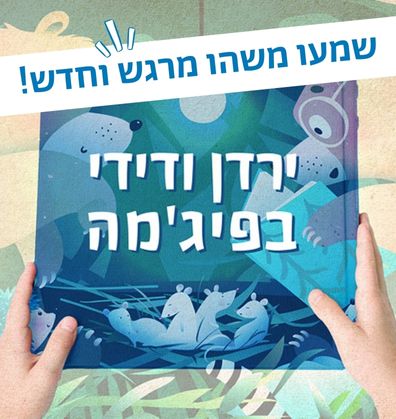מִשְׁפָּחָה וּקְהִלָּה
זיקנה
זיקנה היא חלק ממעגל החיים. מפגש עם אנשים זקנים תורם להתפתחות הרגשית של ילדים וילדות בגיל הרך, מזמן הזדמנויות להשראה וללמידה, ומשכלל את הפרספקטיבה של זמן ותקופה. ספרים העוסקים בזיקנה מעודדים יחס של סקרנות ושל קרבה, בקשר בין דורי.
סְּפָרִים
Book-Related Family Activities

Connections
You can talk about older people you know or knew in the past: Who are they? What is your connection to them? What do you like doing with them now? What memories do you, the parents, have of older figures from your childhood?
Story time
Want to listen to the story? Scan the QR code and you can listen to the story together while turning the pages, at home, in the car or whenever you have time.

Hello Your Majesty
Amira suggests playing a game she played as a child – so can you! How do you play? One participant is the king and the rest are his children coming for a visit. They greet him with “Hello, Your Majesty”. The king replies: “Hello my dear children? Where have you been and what have you been doing?”
The children must explain where they were and what they did in mime, and the king must guess correctly. Then they switch roles.

Party time
Alma is planning a magic party with a magic hat and a magic potion, and invites witches and wizards to join. You can plan a magic party as well, with your own magical ideas. And maybe it will be a “resting” party? Or a game party? Or another themed party of your choice?
Discussion
Parents may want to share the stories they liked while growing up: Was there a particular story you enjoyed hearing over and over again? Who was your favorite protagonist? You could ask your child which stories they like. Are they fictional or true stories?
Dual role illustrations
When do the illustrations tell the story of Leo and Mr. Zinger, and when do they complement the story the two of them made up? You may enjoy taking a look at the illustrations together, noticing the various styles, and thinking of ways of discerning what the illustrations refer to, and what they are telling us.
The story in the hat
Which stories are hidden in the hats you own? how about choosing one of your favorite hats and telling the story that is hiding in it: one player looks into the hat and starts inventing a story. After one or two sentences, they pause, and the next player picks up the story, and so on, until all players have added their part to it. Bashevis Singer could serve as a source of inspiration for telling a family story that has been passed down in your family.
A game – Who am I?
Would you like to play a game? Perhaps you would enjoy writing the names of your favorite characters from books on pieces of paper, and taking turns wearing a hat bearing the name of the character. Whoever wears the hat does not see the name written on the piece of paper attached to it, and must guess who it is using questions, such as: Is it a fictional character? Is it an animal?
Family Activities
- In our story there are things that don’t fit into place, things that are ridiculous and the opposite of what one expects. You can thumb through the pages together, examining the illustrations and discovering these things.
- The children can draw pictures of the grandfather, grandson and the donkey and paste them onto the backs of small magnets. The three characters are invited to set out on a “journey” on the refrigerator door or any oother metal surface. They can take turns, sometimes galloping and sometimes being carried.
- Instead of riding on the donkey, the grandfather and the grandson carry the donkey on their shoulders! Select an object, and use it in a different way than for what it was originally intended. Place a number of household objects with which the children are familiar in a box. Each participant takes out an object and uses it in a way that is different from its intended use.
- Who can keep a straight face? Each person in turn tells the next one: “My donkey, hee-haw,” and tries to get him to laugh. Continue saying this back and forth, faster and faster, until one of you bursts out laughing.
- Grandmother waits at home for Grandfather and the grandson. When they return, she is sure to ask them, “How was your journey?” You and your child can be the grandson and grandfather, and explain in your own words what happened on the way to the city.
- Share funny stories with your child. Think back to funny events that happened to you and share stories from the family lore. Be sure to explain the difference between “laughing at someone” and “laughing with someone”!
Sofma’asehbimachshavatechila (Think before you act)
“Sofma’asehbimachshavatechila” or, “Think before you act,” is an expression taken from the Shabbat hymn “LechaDodi” that Rabbi ShlomoAlkabetz wrote in France about 400 years ago. The hymn tells of G-d’s creating the world in six days with the thought that the Sabbath will arrive at the end of the week and will be the height of the creation.
A person who knows where he wants to go will have an easier time getting there. Is it possible to adopt every suggestion we are offered? How do we know which suggestion is the right one for us?
- When a donkey knows the path he will not stray from it. This is how he brings his rider to his destination in the safest way. Together you’re your child, look at the expression on the donkey’s face throughout the story. What, in your opinion, does he feel on hearing all the advice he receives?
- Each person who passes by gives the grandfather and the grandson advice, and the two become very confused. At the end of the day Grandfather says, “We can’t please everyone.” You can discuss with your child: Who knows us well? Whose advice should we accept? Whose opinion should influence us the least? When should we stand up for our rights and not be drawn into something we know is wrong, on the advice of others?
- Sometimes we feel that what others say is more important than our own inner sense of right and wrong. This is a good opportunity to help your children develop their self-esteem and trust their instincts. The absurd ending of the story illustrates with humor the price of going along with others without giving thought to one’s own beliefs.
- From start to finish: Using toy figurines, you can plan the route of Grandfather, grandson and the donkey with your child. Place pieces of Lego, blocks, or even pillows throughout the room. Before setting out, consider the route together, from the planning stage until the completion of the journey, and move the characters along the way from the stable to the city gate and back home again.
Family Activities:
- Ruthi proclaims that “there’s no other coat like this in the world!” You may ask your children what it is that makes Grandmother’s coat so special. Ask them to describe the coat in their own words. Don’t forget to note the soft material and the surprise-laden pockets! Do you have special clothes or objects that help you feel better? This is an opportunity to remind children of blankets, stuffed animals or a special cloth that help them feel calm in times of distress.
- Dressing up in costume is a wonderful way to foster one’s imagination. You can provide old clothes, hats and other props to encourage your children’s make-believe play. You may dress up in a big old coat and, adding a few other relevant props, can act out the story together.
- Many of us have childhood memories connected to touch. Do you too have a distant recollection of a special piece of clothing? You can share this childhood memory with your child and tell them about the special connection you had with the clothing, or with your grandparents, aunts or uncles.
- The “It’s Like” game: The author Miriam Roth compares the feel of Grandmother’s coat with the fur of a cat. You can make up a word game to play with your children: Place objects made from different materials – e.g., metal, plastic, cloth, etc. – into a large bag. One by one, each player removes an object from the bag and describes the object declaring “It’s soft like…”, “It’s cold like…”, “It’s coarse like…”
- Ask your child to show you the picture depicting Ruthi sick in bed. You can ask them how they feel when they’re sick. What helps us feel better? Do you have any special “family remedies” that were passed down from generation to generation? You can ask a grandparent, aunt or uncle what they recommend to overcome a sad mood or a mild cold.
-
If your child has a grandparent, aunt or adult friend who lives nearby, reading the story together could be a special treat for both of them, and lead to closer relations between the generations.
Miriam Roth
Miriam Roth (1910-2005) was a well-known children’s author and educator. In 1998 she won the UNICEF Smile Award for her book “A Tale of Five Balloons”, and in 2002 was awarded the prestigious Bialik award for literature. Roth’s books include Israeli children’s classics such as “Tiras Cham”, “Maaseh shel Hamisha Balonim”, and “Habayit shel Yael”.
Family Activities
- Perhaps you could look for toys and stuffed animals at home, and use them to act the story out. You may want to keep the toys in a basket, and let your child continue acting the story out themselves.
- You might enjoy looking through the illustrations in the book together. You could take a look at the toy parade on its way to visit Rama. How are they supporting one another?
- You may want to ask your child who they think could use some medical attention aside from Rama. Shula the Doll is injured, her leg fell off a year ago… You may enjoy setting up a toy hospital: take all your “injured” dolls out of the closet, as well as the plastic toys that have lost their leg, or the soldiers who took a hit during playtime, and try to fix or “treat” them.
- Do you know anyone around you (a friend, neighbor, or relative) who is not well? You may want to think of ways ti make them happy together with your child, such as making them a get-well card, calling them up, sending them something yummy, or paying them a proper visit.
- You may want to look at the illustration depicting Rama lying in her bed, unwell but smiling following her toys’ visit. Do you think people who are sick feel better after their friends’ had been to visit them? You may like to tell your child about a visit you had made to a sick person, or one you received when you were unwell.
- Try thinking together – what happened then? What did Rama do once she was well again? What did she tell her toys? How did they welcome her back when she returned to play with them? You could use your own toys to act out the next scenes in the story.
Yemima Avidar-Tchernovitz (1909–1995)
Yemima Avidar-Tchernovitz (1909–1995)
Yemima Avidar-Tchernovitz was born in Lithuania, and immigrated to the Land of Israel when she was 12. She began writing when she was in her teens, and told her early stories to the children in the Tel Aviv kindergartens in which she taught. Her stories were first published in the weekly children’s magazine Davar Liyladim, and she also wrote radio skits, in which she also acted on the “youth corner” broadcasts. Generations of children and youth in Israel grew up reading the dozens of well-loved books she authored, among which are Muki is Angry with Mom, Stories for Nivi, Two Friends on the Road, Eight in Pursuit of One, and One of Ours. Yemima Avidar-Tchernovitz is a Zeev Prize laureate and was also awarded the Israel Prize for Children’s Literature.
Family Activities
- Uncle Aaron and the tractor work the land together: they pull, mow, plow, harrow, fertilize, reap, and tug. There are so many words by which to describe working in the field! You may want to look at the book’s illustrations together, and try to identify which type of work is being carried out in each one.
- You may like to look at Uncle Aaron’s face. Does he seem to be enjoying his work? What do you think he finds enjoyable? Had Uncle Aaron invited you to join him, which type of work would you have wanted to perform with him, and why?
- You could ask Grandpa, Grandma or an older friend to do something with your child that requires life experience and knowledge. For instance: cooking, creating or building something together, learning a song or a few words in a foreign language, or planting some flowers.
- The red tractor went through several “phases”: it worked the soil; served as a children’s toy; and finally drove the kids to fieldtrips. Do you have an item or object that is no longer useful? You may enjoy finding a new use for it together (a cracked bowl can serve as a flowerpot, old clothes can form a costume, etc.).
- Perhaps you would like to build a tractor together using materials you have at home: cardboard tubes, bottle caps, old boxes, etc. You could paint it the most suitable color for a tractor, and get to work!
Enjoy reading and discussing the book together!

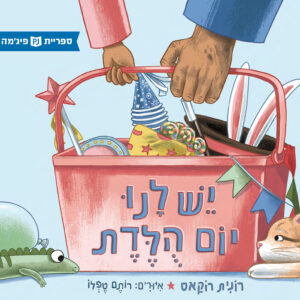 It’s Our Birthday
It’s Our Birthday 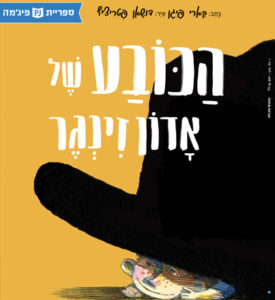 Mr. Zinger’s Hat
Mr. Zinger’s Hat 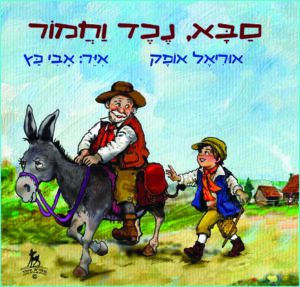 Grandfather, Grandson and a Donkey
Grandfather, Grandson and a Donkey 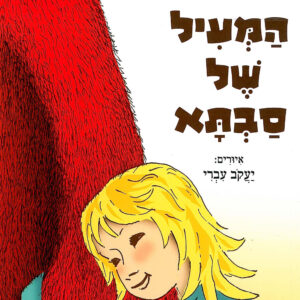 Grandmother’s Coat
Grandmother’s Coat 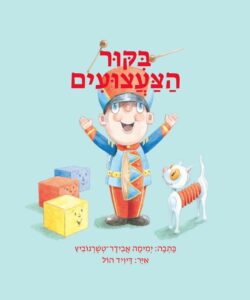 The Toys’ Visit
The Toys’ Visit 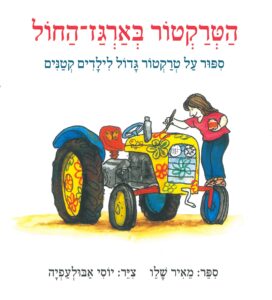 The Tractor in the Sandbox
The Tractor in the Sandbox 


